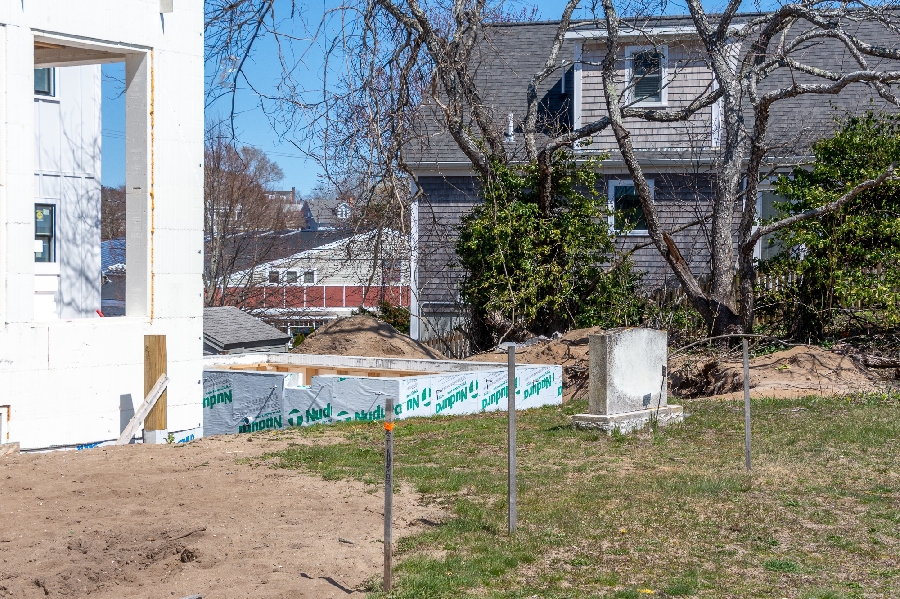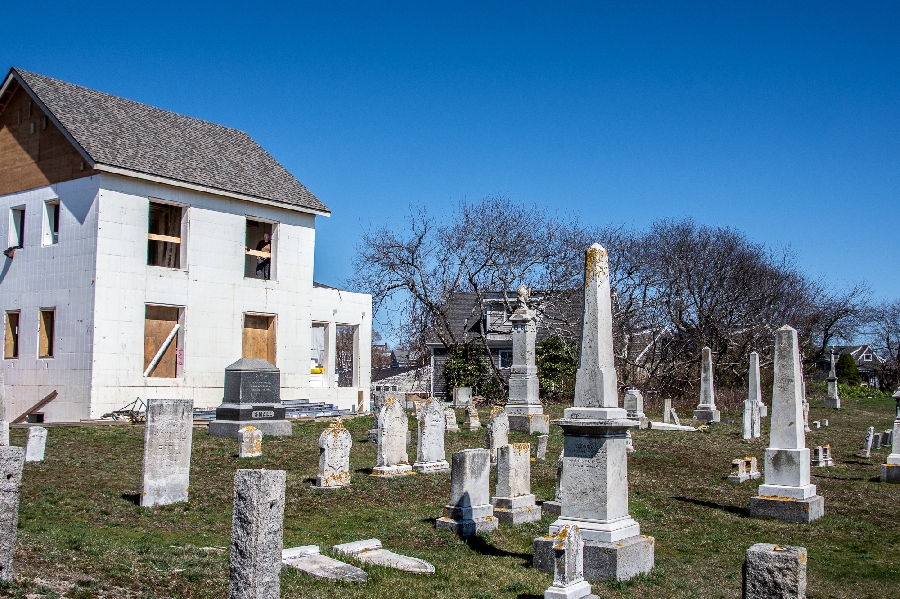PROVINCETOWN — Thom Cusack lives near the town’s Gifford and Hamilton cemeteries and walks daily through the rows of stones marking the final resting places of countless Provincetown residents.
Those morning walks used to be peaceful, he said, but for the last several months he’s watched with consternation as a home being built at 27 Cemetery Road, just outside the town-owned Hamilton Cemetery, has increasingly encroached on a 90-year-old private family burial plot on the property. Lumber and other construction materials have frequently been strewn over the gravestones, including in photos taken by the Independent in April.

“Every time I go by there, it saddens me,” Cusack told the Independent on April 13. Some of his neighbors have told him they feel the same way. “It’s not just me — a lot of us are horrified by it,” he said.
The property that is now 27 Cemetery Road was for more than a century part of a larger 1.1-acre tract at 24 Conwell St. Alexander Roach, who was born on the Caribbean island of St. Vincent in 1870 and came to Provincetown as a crew member on a whaling ship and decided to stay, bought 24 Conwell St. for $65 in 1899. His descendants continued to live there until 2022, and at least four members of his family are buried there.
Approval Not Required
Developer Thomas Tannariello purchased 24 Conwell St. from the family estate for $2.5 million in January 2023 and divided it into four lots under an “approval not required” process, whereby the planning board simply acknowledges that the subdivision plan meets all zoning requirements for lot size, road frontage, and access. The presence of the Roach family’s burial site on the property was not discussed by the planning board before it signed off on the plan.

Two of the four lots that Tannariello created were undeveloped, and he is now building a duplex on one of them, listed as 29 Cemetery Road.
Michael Tamburro and Robert Tucker, who live in New York City, purchased the other undeveloped lot, designated 27 Cemetery Road, which is just under one-sixth of an acre. The couple had been informed of the Roach family’s private cemetery, the Independent reported at the time; Tannariello arranged for a ground-penetrating survey of the burial area and provided the results to Tamburro and Tucker.
A large headstone on the property bears the family names Roach and Watkins. There are four flat markers — two of them dedicated to World War II veterans — and burial records show that there are five family members buried there, and potentially three more, based on obituaries.
According to Gregory Baldwin, a broker for the sale and Tannariello’s partner at the time, the radar survey showed the presence of one body, with the other remains being cremations.
Protecting the Graves
Tucker and Tamburro submitted building plans for a four-bedroom, four-bathroom house of about 2,640 square feet with an attached deck and swimming pool.

The certified site plan, drawn up by an engineer, on file at the building dept., and recorded at the Barnstable County Registry of Deeds, indicates where the burial markers are and notes the presence of three “flags,” with an explanation that the flags mark the location of a body.
That site plan — which was also submitted to the zoning board of appeals — shows the “flags at body” as partly under the planned deck. The headstone and flat grave markers are within a few feet of the deck stairs.
Tamburro provided a written statement to the Independent on April 13: “All construction on our property has been and will continue to be carefully planned and executed to prevent any alteration of the monuments and completely avoid the area with radar reflections consistent with a burial site.”
The presence of a private burial site on a lot being developed was an unfamiliar situation for town officials.
It remains unclear why Roach family members were not buried in the Hamilton Cemetery, which is just a dozen feet away; in 2023, Provincetown Historical Commission chair Julia Perry told the Independent that it could have been due to racism, since the Roach family is Black.
The first burial on the family’s land was likely in 1932, when Alexander Roach died. There are markers there for his wife, Margaret Bryan, who came from South Carolina, and for three of their six children, including Alexander Roach Jr., who died in 1997.
Debra O’Malley, spokesperson for the Secretary of the Commonwealth’s office, which oversees the state historical commission, told the Independent on April 16 that state archeologists can act to protect graves that are either more than 100 years old or Native American. Such situations typically involve the unwitting disturbance of unmarked graves during construction.
The oldest Roach burials fall short of that 100-year benchmark. “The idea is that in the last 100 years, people were being buried in cemeteries, not on private property,” O’Malley said.
In a situation like that at 27 Cemetery Road, protection and oversight could be provided by the town, O’Malley said. “If the town is issuing construction permits or other permits, it could place conditions,” she said. “Then the town would oversee their permits.”
Assistant Town Manager Dan Riviello told the Independent on April 21 that local officials had researched the potential oversight ability the town might have and asked town counsel for guidance.
“Town counsel informed us that the role of the building commissioner is to interpret and enforce the state building code and the town’s bylaws,” Riviello said, “that the building code does not address construction on or near graves or burial sites, and that the town’s bylaws are similarly silent on such matters.”
Town counsel “advised that because private graves are not addressed in the building code or local bylaws, the building commissioner does not have the authority to impose conditions relating to the Roach family graves,” Riviello concluded.
Town Planner Thaddeus Soulé told the Independent that the private cemetery on the residential property presented the town with an unusual dilemma.
“How often does one buy or sell a property with a private cemetery?” Soulé said. He had done some research but found scant information, he said.
A Grandson’s Frustration
James Roach, a grandson of the original landowner, Alexander Roach, and a resident of Provincetown, told the Independent he was frustrated and disappointed by what had happened. He believes his family was not allowed in the town cemetery in the 1930s and ’40s because of their race, “and now they’re doing it again, letting people build right over us.”

Roach said he went to town officials even before building at 27 Cemetery Road had begun, asking whether there were any setback requirements from the burial site. The building commissioner and cemetery commission told him they do not get involved with burials on private property, he said, and officials repeated the advice of town counsel, which was for the Roach family to hire a lawyer. That option was financially impossible, Roach said, adding, “I blame the town.”
Editor’s note: An earlier version of this article, published in print on May 1, erroneously reported that broker Gregory Baldwin and developer Thomas Tannariello were married. They were unmarried partners.
